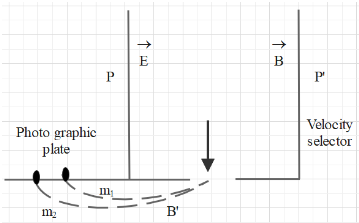
What is the velocity selector mentioned in the passage?

(A) Electric and magnetic field crossed to each other and the electric field parallel to the motion of the particles and
(B) Electric and magnetic field crossed to each other and the magnetic field parallel to the motion of the particles and
(C) The magnetic field, electric field, and velocity mutually perpendicular so that
(D) The magnetic field, electric field, and velocity mutually perpendicular so that

Answer
489.9k+ views
Hint:In this question,we are going to apply the concepts of electric field and magnetic field.In the velocity selector, the electric force acting on the ions is equal to the magnetic forces on them.
Complete step by step answer:
The velocity selector consists of an evacuated region of crossed electric and magnetic fields in the plane of the paper and normal to it. So, the electric field is parallel to the motion of the particles.
The orientations of the two-fields ensure the electric and magnetic forces on the ions are in the same plane and they are so adjusted that the deflections they produce on the ions are in exact opposition. The ions are thus able to pass through the selector without suffering any deflection. Thus, the electric force acting on the ions is equal to the magnetic forces on them.
The electric field in the velocity selector is
So, option A is the correct answer.
Additional information:
The radius r of the ion-path in the field
The velocity selector has direction focussing property and its addition to the mass spectrograph greatly improved its resolving power.
Note:The passage shows a Bainbridge mass spectrograph, which uses a velocity selector that makes the stream of positive ions perfectly homogenous before its entry into the magnetic field, no matter what the initial velocities of the ions are. The emergent ion has very little velocity-spread.
Complete step by step answer:
The velocity selector consists of an evacuated region of crossed electric and magnetic fields in the plane of the paper and normal to it. So, the electric field is parallel to the motion of the particles.
The orientations of the two-fields ensure the electric and magnetic forces on the ions are in the same plane and they are so adjusted that the deflections they produce on the ions are in exact opposition. The ions are thus able to pass through the selector without suffering any deflection. Thus, the electric force acting on the ions is equal to the magnetic forces on them.
The electric field in the velocity selector is
So, option A is the correct answer.
Additional information:
The radius r of the ion-path in the field
The velocity selector has direction focussing property and its addition to the mass spectrograph greatly improved its resolving power.
Note:The passage shows a Bainbridge mass spectrograph, which uses a velocity selector that makes the stream of positive ions perfectly homogenous before its entry into the magnetic field, no matter what the initial velocities of the ions are. The emergent ion has very little velocity-spread.
Recently Updated Pages
Master Class 12 Business Studies: Engaging Questions & Answers for Success

Master Class 12 English: Engaging Questions & Answers for Success

Master Class 12 Social Science: Engaging Questions & Answers for Success

Master Class 12 Chemistry: Engaging Questions & Answers for Success

Class 12 Question and Answer - Your Ultimate Solutions Guide

Master Class 12 Economics: Engaging Questions & Answers for Success

Trending doubts
Most of the Sinhalaspeaking people in Sri Lanka are class 12 social science CBSE

Give 10 examples of unisexual and bisexual flowers

Draw a labelled sketch of the human eye class 12 physics CBSE

Differentiate between homogeneous and heterogeneous class 12 chemistry CBSE

Write a short note on Franklands reaction class 12 chemistry CBSE

Differentiate between insitu conservation and exsitu class 12 biology CBSE




